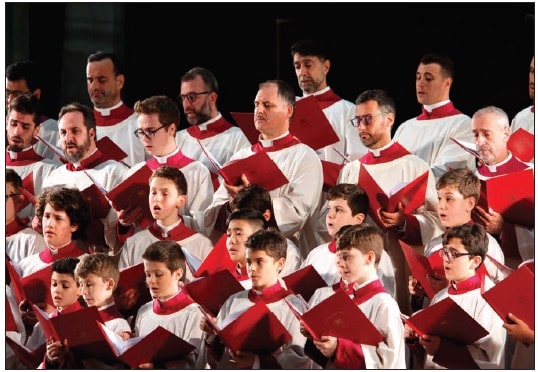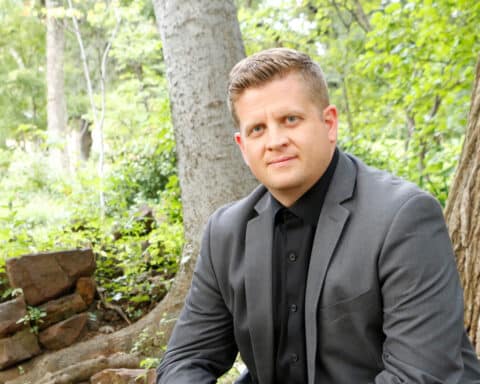Mark Spyropoulos spends three hours a day in music school, practicing with a choir composed of 20 men and 35 boys. The 32-year-old professional baritone from England said the choir leader sometimes has to reprove the children for not paying attention during a rehearsal: “Stop looking at the art, concentrate on the music!”
But their wandering gazes are rather understandable, given that the world’s oldest active choir is standing in the Sistine Chapel.
“God creating Adam, it is a bit distracting,” Spyropoulos said, laughing. “To me, the chapel is the most beautiful artificial thing on the planet. It’s quite intoxicating.”
Music like architecture
The Sistine Chapel Choir from Rome boasts a 1,500-year-old tradition and is set to embark on their first-ever coast-to-coast national tour in the United States this July. Appearances include New York, Los Angeles, Chicago, Atlanta, Boston, Miami, Detroit and St. Louis. The choir toured the U.S. in 2017, but only visited New York, Washington, D.C., and Detroit.
Commonly recognized as “the Pope’s Choir,” Spyropoulos said their primary duty is to sing for papal celebrations, which can average two or three a month. A papal Mass is a worldwide affair, with thousands of people present in a broadcast celebration that requires a free ticket for someone to attend. “We’re all full-time professional singers, so when we’re not rehearsing, we’re touring, we’re recording,” Spyropoulos told Our Sunday Visitor. They’ve traveled around the world, including Moscow, China, England, Germany, Poland and, of course, a substantial amount in Italy.
| 2018 U.S. Tour of the Papal Sistine Chapel Choir |
|---|
|
The Sistine Chapel Choir will perform in eight U.S. cities over three weeks in July. For more details go to sistinechapelchoirtour.com.
– Tuesday, July 3 — Fox Theatre, Atlanta
– Saturday, July 7 — Radio City Music Hall, New York
– Monday, July 9 — The Fabulous Fox Theatre, St. Louis
-Wednesday, July 11 — Detroit Opera House, Detroit
– Friday, July 13 — James L. Knight Center, Miami
– Tuesday, July 17 — Boch Center, Boston
– Saturday, July 21 — Arie Crown Theater, Chicago
– Monday, July 23 — Microsoft Theater, Los Angeles
|
As they tour this summer, the group will be joined by local choirs. “We love America. We always get an incredibly warm reception,” he told OSV. “It’s wonderful for us to be taking our music to lots of different types of choirs in America.”
But the music that makes up the bulk of their repertoire is very special, indeed, “a three-dimensional form of music, called polyphony,” explained Spyropoulos. It dates back to the 16th century — the Renaissance period. “Modern music is generally one big melody,” he said. “This music has four, five, six, seven or eight independent melodic lines that are all sung at the same time and all fit together. It’s very much like architecture. We have to get all those parts to be independent of each other and independently expressive, but at the same time they have to work together to make the whole.”
Unheard for centuries
Maestro Msgr. Massimo Palombella is responsible for bringing back a revival of Renaissance singing to the choir, and he is the only person to have full access to the Vatican’s archives, which date back to the sixth century.
“He has been finding, reviving and studying manuscripts. They’ve been collecting dust in the Vatican archives. We’ve been performing and recording works which have not been heard for centuries,” Spyropoulos said.
The ancient songs were not just written for any choir, however; they were written specifically for the Sistine Chapel Choir, by people who sang in it.
“You’re singing the music that was written specifically for the building at a time when those frescos were, in historical terms, ‘still wet.’ And an experience like that — you kind of have to hold it together, because you have a job to do,” Spyropoulos said. “There’s this perfect connection between the music and the art. If Michelangelo’s frescos could be heard, this is what they’d sound like.”
He said the discovered works were created at a time when printing had just been invented, so there aren’t many clues about how they should be sung today, hundreds of years later; the composer was writing for his friends who sang with each other, sometimes every day. There’s also some considerable experimentation.
“How do you know how big to sing this music? Should you sing it like it’s opera, like it’s Puccini? If you do that in the Sistine Chapel, what you get is a cacophony of overtones, so you can’t hear it,” explained Spyropoulos. “We have to work very much with the acoustics of the building.”
Musical ecumenism
Spyropoulos began singing at the age of 10. He attended a Catholic boarding school in Sussex in southern England and sang all the way through. He studied opera in England and traveled with various companies around the U.K. and continental Europe.
He then went to Italy and connected with Palombella in 2015, who was fascinated at that time by the English choral tradition — a tradition in which Spyropoulos is very comfortable.
“In England, we’re very good at the discipline and the rigor that comes with music, the musicality. What we’re not so good at is the emotional; we have to work much harder at that,” he said. But “my experience of Italian singers is almost the exact opposite. The Italians tend to connect very strongly and very immediately with music, but sometimes it needs the discipline to make the kind of homogeneity that’s required.”
He is Catholic, but up until his move to Rome, most of his singing was for Anglican choirs. Having the outside perspective is very useful in his current role in the papal choir. Pope Francis (“who stopped and had a chat with me”; he keeps a framed photo of the meeting on his wall) talks about practical ecumenism with other Christians denominations, particularly ones that have a choral tradition. “It’s a very beautiful way of collaborating,” he said, citing their performance at Martin Luther’s church for the 500th anniversary of the Reformation.
“To have this Catholic choir representing the pope singing at the church of Wittenberg was a wonderful and quite emotional moment of reconciliation,” he said.
And, of course, he is excited to share his craft this July. “We have to inspire people. It’s a great pleasure to be doing that, and I hope to do that on this tour,” he said.





